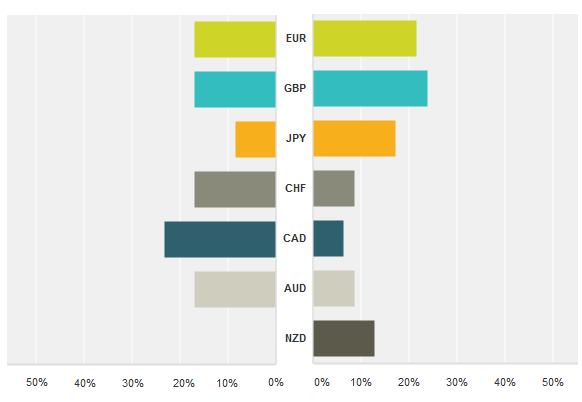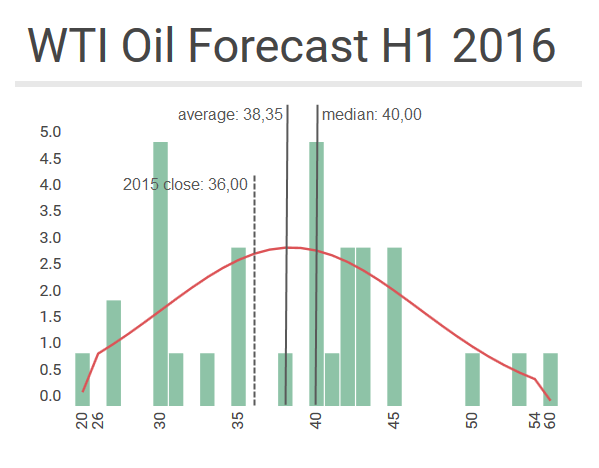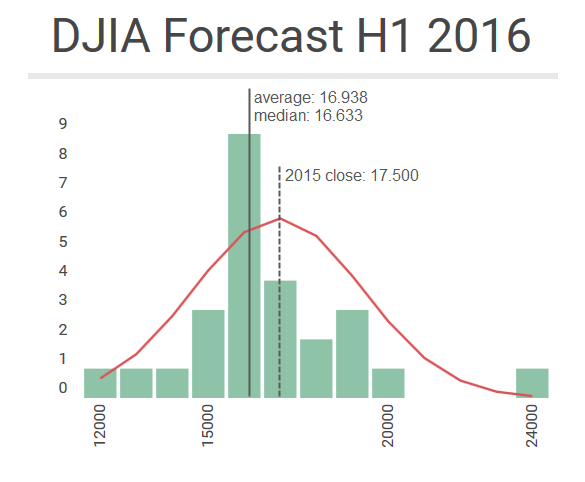We got 48 answers and here we present the results of the first part of this survey, which was about predicting the best and worst performing major FX pairs and the first semester prices of the most traded assets in the markets.
Which of these currencies do you expect to perform the best against the USD in 2016? And the worst?

This two-way chart allows us to show the bull/bear side of how the main currencies may perform against the US Dollar during 2016. At the right side you can view the amount of contributors predicting each currency to be the best performing of the list against the USD, while at the left side the worst-performers votes are represented.
The chart shows some interesting trends, as the slightly more bullish than bearish result in the EUR (10 bulls, 8 bears) and the GBP (11 bulls, 8 bears), which is kind of odd if we consider the price predictions we will read later, specially in the British Pound. The JPY (8 bulls, 4 bears) and the NZD (6 bulls, 0 bears) are the currencies more clearly bullish (yes, no one thinks the kiwi will be the worst performer in 2016), while the CHF (4 bulls, 8 bears), the AUD (also 4 and 8) and specially the CAD (3 bulls, 11 bears) are notably bearish.
Which price do you foresee for the EURUSD at the end of the first semester of 2016?
_20160107150048.png)
EURUSD closed the year around 1.08 and the average forecast from our contributors is placed just a pip short of that level, at 1.0799, meaning that the bulls/bears are split 50-50. It's interesting to notice, looking at the histogram, that the mode of predictions is located around parity, with most of the bears constrained in a quite tight range (1.00-1.05). On the opposite side, the bulls are quite spread going from 1.10 to 1.31.
Which price do you foresee for the GBPUSD at the end of the first semester of 2016?
_20160107150131.png)
Regarding the cable, the answers of our contributors show a slight bearish bias. The average forecast is placed in 1.4808, a few pips below the 2015 close. Again, it's interesting to notice that the mode (1.45) is located far from the average and the lowest forecast (1.3) is more far than the highest (1.64), which may reinforce the bearish bias observed.
Which price do you foresee for the USDJPY at the end of the first semester of 2016?
_20160107150209.png)
Our contributors are on average bullish on the USDJPY. The average forecast is at 122.00, clearly over the 120.40 where the pair closed last year. It is noticeable the symmetric distribution of the histogram here, with 122-123 acting as the mode and similar spreads on both sides. Both the lowest (100) and the highest (150) are quite extreme but similarly spread from the average. Therefore, with the latter being clearly over the close, we can settle for a bullish bias on this one.
Which price do you foresee for Gold at the end of the first semester of 2016?
_20160107150245.png)
This is an interesting histogram, as there are significant levels all over the chart. At first glance, we observe the average (1047) really close to the last price of 2015 (1050), but there are only three contributors predicting the gold price to be between 1030 and 1070 at the end of the first semester. The mode is located quite below, at the round price of 1000, but there are also significant accumulations of forecasts around 950, 1100 and 1150. Therefore, we can infer that gold price will be an asset tough to predict going forward, with bulls and bears quite convinced they can take the price to their side but eventually could cancel each other.
Which price do you foresee for the WTI Oil barrel at the end of the first semester of 2016?

It's kind of surprising to look at this histogram just when oil is occupying headlines with its recent 12-year lows, but our contributors are actually bullish on average. The WTI barrel closed the year at 36$ and the average forecast for the first half of 2016 is at 38.35$. There are two modes, one at 30$ and another at 40$, but the second one has a significant amount of observations around, with 15 of the 33 predictions (a considerable 45%) stuck in the 40$-45$ range.
Which price do you foresee for the DJIA at the end of the first semester of 2016?

We also got a bonus question on a stocks index. Here we have a more predictable outcome. The DJIA forecasts are bearish on average but most of the observations are located around the 16000-18000 range, where the index closed 2015.
Click here to read the second part of the survey, about macroeconomic topics and trends.
Information on these pages contains forward-looking statements that involve risks and uncertainties. Markets and instruments profiled on this page are for informational purposes only and should not in any way come across as a recommendation to buy or sell in these assets. You should do your own thorough research before making any investment decisions. FXStreet does not in any way guarantee that this information is free from mistakes, errors, or material misstatements. It also does not guarantee that this information is of a timely nature. Investing in Open Markets involves a great deal of risk, including the loss of all or a portion of your investment, as well as emotional distress. All risks, losses and costs associated with investing, including total loss of principal, are your responsibility. The views and opinions expressed in this article are those of the authors and do not necessarily reflect the official policy or position of FXStreet nor its advertisers. The author will not be held responsible for information that is found at the end of links posted on this page.
If not otherwise explicitly mentioned in the body of the article, at the time of writing, the author has no position in any stock mentioned in this article and no business relationship with any company mentioned. The author has not received compensation for writing this article, other than from FXStreet.
FXStreet and the author do not provide personalized recommendations. The author makes no representations as to the accuracy, completeness, or suitability of this information. FXStreet and the author will not be liable for any errors, omissions or any losses, injuries or damages arising from this information and its display or use. Errors and omissions excepted.
The author and FXStreet are not registered investment advisors and nothing in this article is intended to be investment advice.
Recommended Content
Editors’ Picks
EUR/USD edges lower toward 1.0700 post-US PCE

EUR/USD stays under modest bearish pressure but manages to hold above 1.0700 in the American session on Friday. The US Dollar (USD) gathers strength against its rivals after the stronger-than-forecast PCE inflation data, not allowing the pair to gain traction.
GBP/USD retreats to 1.2500 on renewed USD strength

GBP/USD lost its traction and turned negative on the day near 1.2500. Following the stronger-than-expected PCE inflation readings from the US, the USD stays resilient and makes it difficult for the pair to gather recovery momentum.
Gold struggles to hold above $2,350 following US inflation

Gold turned south and declined toward $2,340, erasing a large portion of its daily gains, as the USD benefited from PCE inflation data. The benchmark 10-year US yield, however, stays in negative territory and helps XAU/USD limit its losses.
Bitcoin Weekly Forecast: BTC’s next breakout could propel it to $80,000 Premium

Bitcoin’s recent price consolidation could be nearing its end as technical indicators and on-chain metrics suggest a potential upward breakout. However, this move would not be straightforward and could punish impatient investors.
Week ahead – Hawkish risk as Fed and NFP on tap, Eurozone data eyed too

Fed meets on Wednesday as US inflation stays elevated. Will Friday’s jobs report bring relief or more angst for the markets? Eurozone flash GDP and CPI numbers in focus for the Euro.